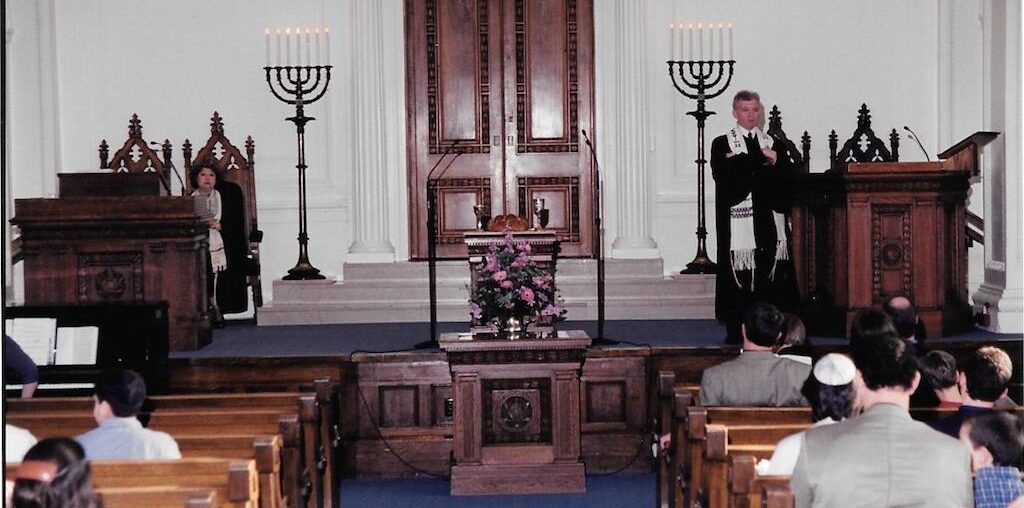Again this year the COVID-19 pandemic interfered with the celebration of the High Holy Days at our temple. Recently I drove through the queue in the parking lot to pick up honey sticks, a round loaf of raisin Challah, and prayer books to be used for the holiday services. It was a good way to introduce myself to the new rabbi who will serve as interim for two years while the Trustees search for a fulltime rabbi for our Reform congregation, the only one in this part of our state.
The surface of the parking lot is broken in many places, and the spaces are no longer lined. One whole row of parking spots is now leased to university students who rent apartments in the building next door, a way to generate a bit of extra income. Those cars bear primarily out-of-state license plates and are generally fancier than those of most congregants.
I have not been inside our temple building for more than 18 months due to the pandemic. But the real story started when the Board decided that the congregation could no longer support the building, this place of worship and community that traces its roots in our city back to 1839, making it the ninth-oldest Jewish congregation in the U.S. The building in whose parking lot I sit today was dedicated in 1911, and the Religious School wing was added in 1961.
We joined this temple in 1994 when we moved from southern California to upstate New York. Our daughter, Sophie, was just three years old, so this is the temple where she grew up. For 15 years, temple was at the centre of our lives – Religious School every Sunday morning, Hebrew school every Wednesday evening, services once or twice a month on Friday evenings, committee meetings for me every few months.
The sanctuary itself is magnificent, with tall stained-glass windows, incredibly high ceilings, and gleaming wooden pews. We always sat on the right side facing the bima, although I do not remember every choosing to do so. Over the years we often sat with other families who had children around Sophie’s age. We witnessed the children become Bar and Bat Mitzvah, and, eventually Confirmands. Many (including Sophie) volunteered as teaching assistants after seventh grade, through all the years of high school. Temple was the place where we attended family potluck dinners on Shabbat, ate honey and apples at Rosh Hashanah, participated in seders at Passover, and ate latkes at the annual Hanukkah dinner.
So, when it was announced in 2019 that the congregation could no longer afford to stay in the building, my heart sank. We read all the materials sent to us as temple members in preparation for the required vote to accept the $9 million offer by a developer who promised to save the sanctuary while building luxury student apartments around it. That July the congregation overwhelmingly agreed with the recommendation of the Trustees to sell the building, and we did too, despite our grave misgivings. Our daughter was crushed when she heard the news. She had moved out of the area in 2015 and had not been to temple since. We ourselves attended mainly for the High Holy Days, but we remained members out of loyalty even though our beloved rabbi had retired.
The sale of the building has moved forward at an agonisingly slow pace. The developer changed plans several times, and historical preservation groups rushed in to object to the sale of this building because of its national historical significance. Congregational committees have found a temporary home for the congregation in space within a local Conservative Temple. Other committees have started to catalog all of the religious artefacts, school supplies, and kitchenware that live in the building. At the High Holy Days in 2019, I attended services with a sense of dread, believing it might be the last time. But I never expected the end to come in only a few months when COVID-19 closed the building and led to virtual services.
Some years ago, a local physician who is also a talented photographer took photos of the interior of the sanctuary and many of the artefacts in the glass-fronted cabinets lining the hallway. The photos were made into notecards, with profits from the sales to benefit some temple fund. There are still several left in the box we purchased. Every few months I peruse the remaining cards as a way of preserving my memories of our temple. But nothing could ever make me forget the sense of belonging I felt there, me the non-Jewish part of an interfaith family, the one our daughter often called “a little bit Jewish.”

